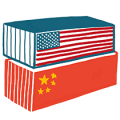

Will American and Chinese Societies Support a New Type of Cold War?
Leaders on both sides are taking a more confrontational line, but are the people willing to go along?
As bilateral relations between America and China continue to deteriorate, pundits seem to be converging on a “new type of Cold War” as the most plausible scenario for future world politics. That assumes that both societies will allow their leaders to rouse them for that contest. But will they?
If the world is heading into a new Cold War, it is worth reflecting on how it got into, and out of, the old Cold War. In the last analysis, such global contests are decided by societies: it is the people who have to sustain the effort and carry the burden of prolonged great power competition. So it is worth asking how the Chinese and American people will respond to the “call to arms” (so far mostly metaphorically) by their leaders for that new type of Cold War?
Building social support will not be a picnic
Building long-lasting and broad-based social support for the burdens associated with a new Cold War won’t be easy. In the first half of the 20th century, in the wake of World War I and after the Great Depression, American society and politics largely failed to support a greater American role and responsibility in global affairs. It took the Battle of Britain and Pearl Harbor to bring America into World War II and to forge domestic support for a new, post-war international order in which the United States took center stage. Even during the Cold War, mobilizing American society to support and sustain a global contest against the Soviet Union at times was difficult and risky; the means deployed by politicians — such as stirring anti-communist paranoia — sometimes took American democracy to the brink.
Now, with American society riven by polarizing political and socioeconomic cleavages, some of its leaders, including the president, are zooming in on a new enemy, China, to unite and rouse the United States. What may have begun as a calculated effort to establish “reciprocity” and a “fair playing field” in U.S.-China trade relations risks degenerating into an all-out effort to mobilize the country, complete with “clash of civilizations” and racial overtones, against the latest in a long line of perceived existential threats.
Of course, China’s leaders are not newcomers to the game of mobilizing society against foreign threats, real and imagined. On several occasions, Mao Zedong fanned the flames of Chinese public animosity against the United States to bolster his efforts at “permanent revolution,” including bringing China and the U.S. to the brink of armed conflict over Taiwan in 1958. After the Tiananmen protests and massacre in 1989, China launched its “patriotic education” campaign to imbue future generations of Chinese youth with nationalist sentiment: reinvigorating the message that never again was China to be “humiliated” by the West. Since claiming the top job in the Chinese Communist Party (CCP) in 2012, Xi Jinping has doubled down on nationalist slogans like the “great rejuvenation of the Chinese Nation,” the Chinese counterpart to “Make America Great Again.” Overall, and especially in light of the coronavirus pandemic, the CCP propaganda machine has gone into high gear to foment public anger at American and other foreign criticisms of China’s response to the virus. Despite Foreign Minister Wang Yi’s recent claim that only the United States is provoking a new Cold War, Chinese leaders are in the midst of a full-scale re-evaluation of longstanding commitments to interdependence, including calls for societal sacrifice in the name of “self-reliance” and “strategic autonomy.”
China and the United States remain deeply intertwined
At the same time, even in the middle of the trade war with the United States, Chinese officials continued to cultivate foreign direct investment from American and European companies in China. Similarly, the seemingly straightforward bipartisan consensus on China in the United States belies a great deal of variation in positions and interests even among the most hawkish of China hawks. Those contradictions may seem puzzling at first glance, but they point to a big obstacle in the way of forging broad societal backing for a new type of Cold War: China and the United States remain deeply intertwined, not only commercially but also socially and even culturally. Even if their current leaders are dead-set on propelling them into a new, multigenerational Cold War style rivalry, Chinese and American societies therefore have good reason to remain skeptical.
Efforts at “decoupling” and reducing interdependence will likely aggravate rather than resolve mutual vulnerabilities. Waging a new kind of Cold War would also be enormously risky and costly: the chances of “winning” are negligible while the risks of both paying a high price in the loss of wealth, power, and prestige are huge. Ultimately, even more serious than their very real bilateral conflicts of interest and values are the long-term challenges facing America and China: truly global problems such as climate change, pandemics, or runaway technological change,
Despite the ongoing COVID-19 pandemic, both China and America are engaged in a race to the bottom, with powerful forces promoting conspiracy theories about the origins of the coronavirus amid rallying cries in support of an inevitable great power showdown. Ultimately, if they determine that their leaders’ actions paving the way for a new Cold War are more likely to diminish than to bolster their country’s prosperity, strength, and security, American and Chinese societies may yet choose not to show up for this 21st century existential rivalry.
This article was first published by The Diplomat on June 18, 2020.



